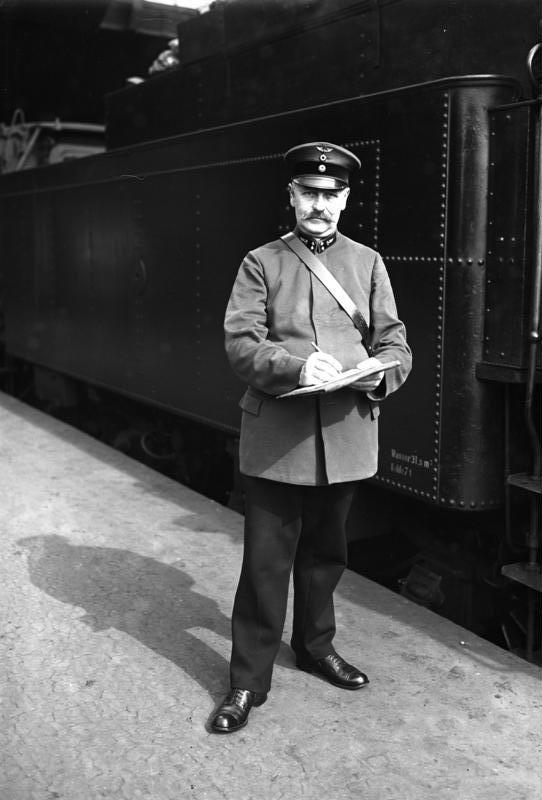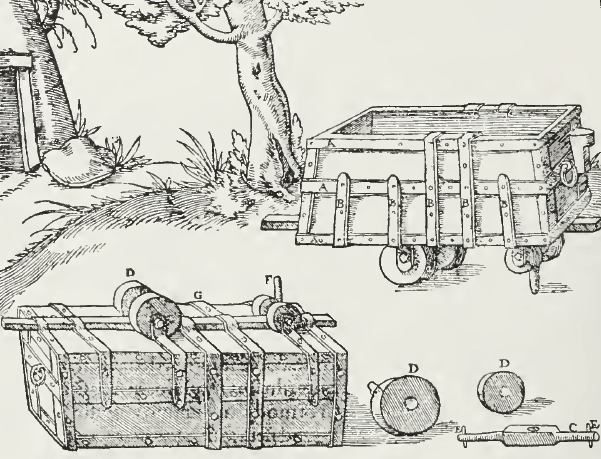|
German State Railway Wagon Association
The German State Railway Wagon Association (german: Deutscher Staatsbahnwagenverband) or DWV was an association of the German state railways ''Länderbahnen'' founded in 1909. The purpose of the association was to guarantee the unrestricted exchange of goods wagons between the member railway administrations. The German State Railway Wagon Association could, unlike the ''Prussian State Railway Wagon Association'', stipulate standard wagon designs for the whole of Germany. It developed a total of eleven different wagon types, the ''Verbandsbauart'' (literally: association type) or ''DWV'' wagons. In addition to entire goods wagons, types of bogie were also specified. End With the founding of the Deutsche Reichsbahn on 1 April 1920 the DWV closed its operations. Preußische und Hessische Eisenbahndirektion in Mainz (publ.): ''Amtsblatt der Preußischen und Hessischen Eisenbahndirektion in Mainz'' dated 26 June 1920, No. 39. Bekanntmachung No. 577, p. 329. References See also * ... [...More Info...] [...Related Items...] OR: [Wikipedia] [Google] [Baidu] |
Länderbahnen
The ''Länderbahnen'' (singular: ''Länderbahn'') were the various state railways of the German Confederation and the German Empire in the period from about 1840 to 1920, when they were merged into the Deutsche Reichsbahn after the First World War. The state railways Railways merged into the Deutsche Reichsbahn The seven state railways forming the merger were the: *Prussian state railways (''Preußische Staatseisenbahnen'' or ''P.St.E.'') *Royal Bavarian State Railways (''Königlich Bayerische Staatseisenbahn'' or ''K.Bay.Sts.B.'') *Royal Saxon State Railways (''Königlich Sächsische Staatseisenbahnen'' or ''K.Sächs.Sts.E.B.'') *Royal Württemberg State Railways (''Königlich Württembergische Staatseisenbahn'' or ''K.W.St.E.'') *Grand Duchy of Baden State Railways (''Großherzoglich Badische Staatseisenbahn'' or ''G.Bad.St.E.''), 1840–1920 *Grand Duchy of Mecklenburg Friedrich-Franz Railway (''Großherzoglich Mecklenburgische Friedrich-Franz-Eisenbahn'' or ''M.F.F.E.'') * Gr ... [...More Info...] [...Related Items...] OR: [Wikipedia] [Google] [Baidu] |
Goods Wagons
Goods wagons or freight wagons (North America: freight cars), also known as goods carriages, goods trucks, freight carriages or freight trucks, are unpowered railway vehicles that are used for the transportation of cargo. A variety of wagon types are in use to handle different types of goods, but all goods wagons in a regional network typically have standardized couplers and other fittings, such as hoses for air brakes, allowing different wagon types to be assembled into trains. For tracking and identification purposes, goods wagons are generally assigned a unique identifier, typically a UIC wagon number, or in North America, a company reporting mark plus a company specific serial number. Development At the beginning of the railway era, the vast majority of goods wagons were four- wheeled (two wheelset) vehicles of simple construction. These were almost exclusively small covered wagons, open wagons with side-boards, and flat wagons with or without stakes. Over the course of ... [...More Info...] [...Related Items...] OR: [Wikipedia] [Google] [Baidu] |
Verbandsbauart
The German term ''Verbandsbauart'' describes both a type of goods wagon as well as a type of tram. In order to standardise the goods wagons classes of the various German state railways (''Länderbahnen''), the German State Railway Wagon Association (''Deutscher Staatsbahnwagenverband'' or ''DWV'') issued regulations. The so-called ''Verbandsbauart'' (association) or ''DWV'' wagons, named after this association, were built from 1910 until the emergence of the Austauschbauart (interchangeable) wagons in 1927. Externally, the ''Verbandsbauart'' wagons looked very much like state railway goods wagons, but they were equipped for considerably higher maximum loads of up to 20 tons. A total of 11 classes were defined by norms defined by master engineering drawings (''Musterblättern'').Literally "design sheets"; hence the specific wagon designs are referred to here as "Sheet X" The wagons were built in numbers that today are hardly conceivable. The most important ones were the A2 and A10 ... [...More Info...] [...Related Items...] OR: [Wikipedia] [Google] [Baidu] |
Bogie
A bogie ( ) (in some senses called a truck in North American English) is a chassis or framework that carries a wheelset, attached to a vehicle—a modular subassembly of wheels and axles. Bogies take various forms in various modes of transport. A bogie may remain normally attached (as on many railroad cars and semi-trailers) or be quickly detachable (as the dolly in a road train or in railway bogie exchange); it may contain a suspension within it (as most rail and trucking bogies do), or be solid and in turn be suspended (as most bogies of tracked vehicles are); it may be mounted on a swivel, as traditionally on a railway carriage or locomotive, additionally jointed and sprung (as in the landing gear of an airliner), or held in place by other means (centreless bogies). In Scotland, the term is used for a child’s (usually home-made) wooden cart. While ''bogie'' is the preferred spelling and first-listed variant in various dictionaries, bogey and bogy are also used. Rai ... [...More Info...] [...Related Items...] OR: [Wikipedia] [Google] [Baidu] |
Deutsche Reichsbahn (1920–1945)
The ''Deutsche Reichsbahn'', also known as the German National Railway, the German State Railway, German Reich Railway, and the German Imperial Railway, was the German national railway system created after the end of World War I from the regional railways of the individual states of the German Empire. The ''Deutsche Reichsbahn'' has been described as "the largest enterprise in the capitalist world in the years between 1920 and 1932"; nevertheless its importance "arises primarily from the fact that the Reichsbahn was at the center of events in a period of great turmoil in German history". Overview The company was founded on 1 April 1920 as the ("German Imperial Railways") when the Weimar Republic, which still used the nation-state term of the previous monarchy, (German Reich, hence the usage of the in the name of the railway; the monarchical term was ), took national control of the German railways, which had previously been run by the German states. In 1924 it was reorganise ... [...More Info...] [...Related Items...] OR: [Wikipedia] [Google] [Baidu] |
History Of Rail Transport In Germany
:''This article is part of the history of rail transport by country series'' The history of rail transport in Germany can be traced back to the 16th century. The earliest form of railways, wagonways, were developed in Germany in the 16th century. Modern German rail history officially began with the opening of the steam-powered Bavarian Ludwig Railway between Nuremberg and Fürth on 7 December 1835. This had been preceded by the opening of the horse-drawn Prince William Railway on 20 September 1831. The first long-distance railway was the Leipzig-Dresden railway, completed on 7 April 1839. Forerunners The forerunner of the railway in Germany, as in England, was to be found mainly in association with the mining industry. Mine carts were used below ground for transportation, initially using wooden rails, and were steered either by a guide pin between the rails or by flanges on the wheels. A wagonway operation was illustrated in Germany in 1556 by Georgius Agricola (image right) i ... [...More Info...] [...Related Items...] OR: [Wikipedia] [Google] [Baidu] |
1909 Establishments In Germany
Nineteen or 19 may refer to: * 19 (number), the natural number following 18 and preceding 20 * one of the years 19 BC, AD 19, 1919, 2019 Films * ''19'' (film), a 2001 Japanese film * ''Nineteen'' (film), a 1987 science fiction film Music * 19 (band), a Japanese pop music duo Albums * ''19'' (Adele album), 2008 * ''19'', a 2003 album by Alsou * ''19'', a 2006 album by Evan Yo * ''19'', a 2018 album by MHD * ''19'', one half of the double album ''63/19'' by Kool A.D. * ''Number Nineteen'', a 1971 album by American jazz pianist Mal Waldron * ''XIX'' (EP), a 2019 EP by 1the9 Songs * "19" (song), a 1985 song by British musician Paul Hardcastle. * "Nineteen", a song by Bad4Good from the 1992 album ''Refugee'' * "Nineteen", a song by Karma to Burn from the 2001 album ''Almost Heathen''. * "Nineteen" (song), a 2007 song by American singer Billy Ray Cyrus. * "Nineteen", a song by Tegan and Sara from the 2007 album '' The Con''. * "XIX" (song), a 2014 song by Slipknot. ... [...More Info...] [...Related Items...] OR: [Wikipedia] [Google] [Baidu] |
Rail Freight Transport In Germany
Rail or rails may refer to: Rail transport *Rail transport and related matters *Rail (rail transport) or railway lines, the running surface of a railway Arts and media Film * ''Rails'' (film), a 1929 Italian film by Mario Camerini * ''Rail'' (1967 film), a film by Geoffrey Jones for British Transport Films *'' Mirattu'' or ''Rail'', a Tamil-language film and its Telugu dub Magazines * ''Rail'' (magazine), a British rail transport periodical * ''Rails'' (magazine), a former New Zealand based rail transport periodical Other arts *The Rails, a British folk-rock band * Rail (theater) or batten, a pipe from which lighting, scenery, or curtains are hung Technology *Rails framework or Ruby on Rails, a web application framework *Rail system (firearms), a mounting system for firearm attachments *Front engine dragster *Runway alignment indicator lights, a configuration of an approach lighting system *Rule Augmented Interconnect Layout, a specification for expressing guidelines for pri ... [...More Info...] [...Related Items...] OR: [Wikipedia] [Google] [Baidu] |



